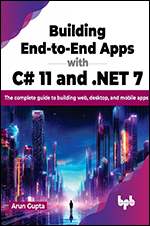WPF Recipes in C# 2008: A Problem-Solution Approach
- 7h 32m
- Allen Jones, Sam Bourton, Sam Noble
- Apress
- 2008
WPF offers amazing new opportunities to .NET programmers in terms of the user interfaces they can deliver to their customers. But this significant technological advance comes with a steep learning curve, requiring the programmer to learn new classes, new syntax, and an entirely new approach to UI development.
Although WPF has been generally available for over a year, commercial take–up has been relatively slow, and the publicly available body of knowledge has been weak in terms of real–world examples and best–practice information.
Using WPF Recipes in C# 2008, you’ll find a simple and straightforward approach to solving the problems you face every day. Each solution contains a complete, working example that demonstrates how to make the best use of WPF. You can use the example as a template to solve your own problem or as a base on which to build a solution tailored to your specific needs.
Packed with well–structured and documented solutions to a broad range of common WPF problems, this book, which presents the only WPF recipes currently published, will be a valuable addition to any C# programmer’s reference library. Examples included provide you with a rich source of information as you begin to learn and will be an invaluable quick–reference guide once you’re a proficient WPF programmer.
The emphasis on solving the day–to–day WPF problems that all programmers face frees you from needing to trawl through weighty programming tomes or sift through API documentation, allowing you to focus on the more interesting and innovative aspects of your project.
What you’ll learn
- Get hands–on experience applying WPF to real–world business applications.
- Find quick answers to common problems.
- Develop a new mindset to UI development and a new approach to implementation from the authors’ experience in graphics.
- Peruse clear and concise code samples that demonstrate solutions to specific problems.
Who is this book for?
This book will benefit intermediate–to–advanced professional C# programmers who want clearly documented and working code samples that demonstrate solutions to common problems encountered when programming WPF. The authors believe WPF technology is new and complex enough, and their experience is deep enough that their recipes will provide value to all but the most experienced WPF programmers.
About the Authors
SAM NOBLE is a software developer who has been using .NET for several years in the land of academia, creating 3D graphics pipelines, artificial neural networks, image-processing tools, and a theoretical 4D spacetime computer compiler and emulator, amongst other things. Sam is currently a developer for SmithBayes where he has been using .NET 3.0+ industrially since the early CTP releases, fully embracing WPF and all it has to offer to create sophisticated strategic visualization tools.
SAM BOURTON is a technologist with ten years of commercial experience as a software designer and developer, across a wide variety of industries including e-commerce, telecoms, and Formula 1 motor racing. He has been using the .NET Framework since the very first beta and has been using WPF since the early CTPs. He has a passion for design patterns, application architecture, and best-practice object-oriented design and methodologies.
ALLEN JONES has 20 years of experience covering a wide range of IT disciplines in a variety of sectors; however, his true passion has always been software development. Allen is currently the the Chief Architect at SmithBayes, a UK-based firm that develops an agile decision platform which provides strategic decision support to senior executives in large corporations.
In this Book
-
Building and Debugging WPF Applications
-
Working with Windows, Forms, and Layout Management
-
Using Standard Controls
-
Creating User and Custom Controls
-
Data Binding
-
Working with Styles, Templates, Skins, and Themes
-
Working with Text, Documents, and Printing
-
Multithreading
-
Working with 2D Graphics
-
Working with 3D Graphics
-
Creating Animation
-
Dealing with Multimedia and User Input
-
Migrating and Windows Forms Interoperability




